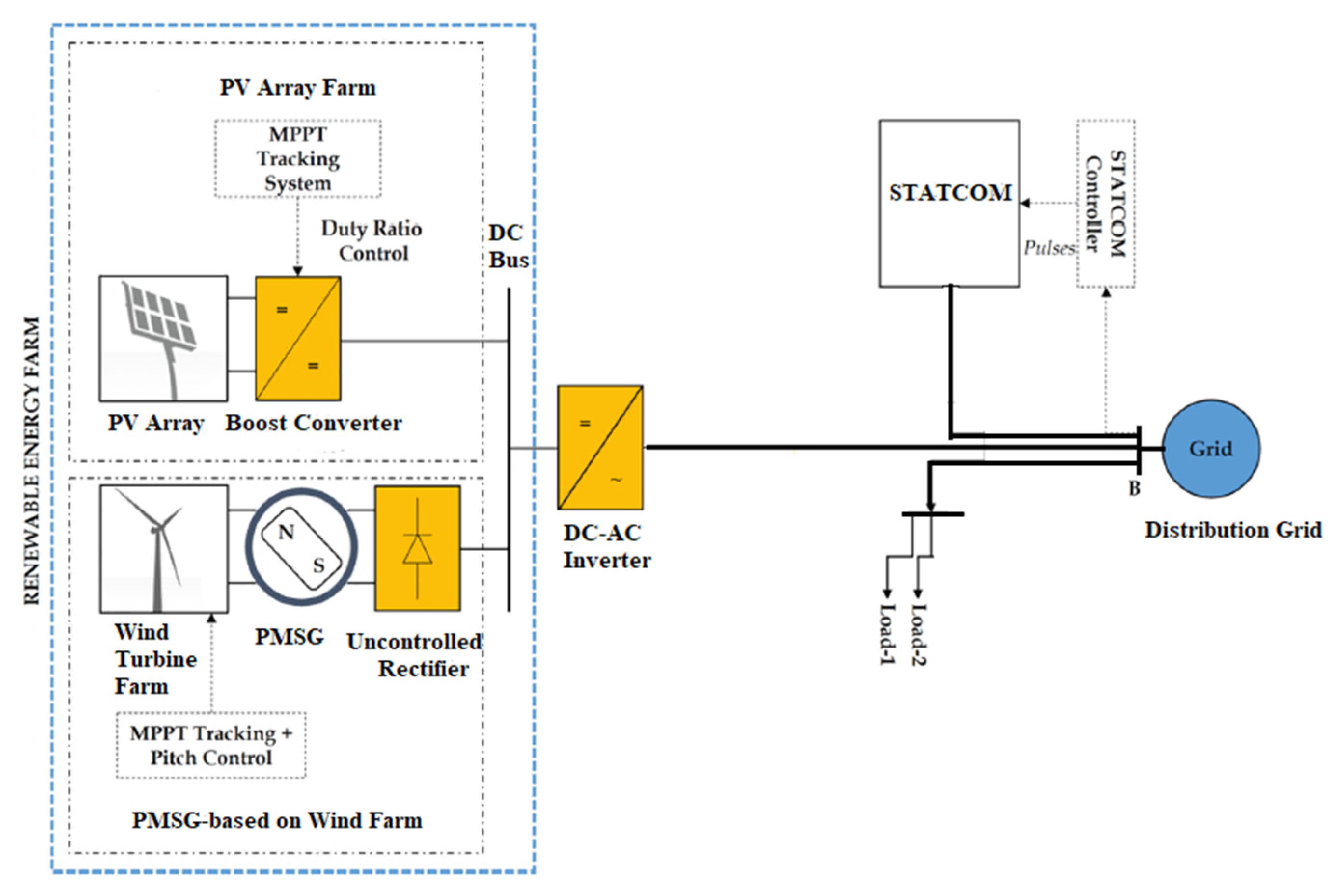Modeling and Analysis of STATCOM for Renewable Energy Farm to Improve Power Quality and Reactive Power Compensation †
Abstract
:1. Introduction
2. System Model
3. Methodology
Hysteresis Current Control Technique
4. Results and Discussion
4.1. Load Source Current
4.2. Reactive Power by Load and STATCOM
4.3. FFT Analysis
5. Conclusions
Conflicts of Interest
References
- Mekhilef, S.; Saidur, R.; Kamalisarvestani, M. Effect of dust, humidity and air velocity on efficiency of photovoltaic cells. Renew. Sustain. Energy Rev. 2012, 16, 2920–2925. [Google Scholar] [CrossRef]
- Jamil, B.; Siddiqui, A.T.; Akhtar, N. Estimation of solar radiation and optimum tilt angles for south-facing surfaces in Humid Subtropical Climatic Region of India. Eng. Sci. Technol. Int. J. 2016, 19, 1826–1835. [Google Scholar] [CrossRef] [Green Version]
- Gandoman, F.H.; Ahmadi, A.; Sharaf, A.M.; Siano, P.; Pou, J.; Hredzak, B.; Agelidis, V.G. Review of FACTS technologies and applications for power quality in smart grids with renewable energy systems. Renew. Sustain. Energy Rev. 2018, 82, 502–514. [Google Scholar] [CrossRef]
- Jamil, E.; Hameed, S. STATCOM-Based Voltage Regulation in Grid Integrated Wind Farm under Variable Loading Conditions. In Proceedings of the 2017 14th IEEE India Council International Conference (INDICON), Roorkee, India, 15–17 December 2017. [Google Scholar]
- Sinha, S.; Chandel, S.S. Improving the reliability of photovoltaic-based hybrid power system with battery storage in low wind locations. Sustain. Energy Technol. Assess. 2017, 19, 146–159. [Google Scholar] [CrossRef]
- Maatallah, T.; Ghodhbane, N.; Nasrallah, S.B. Assessment viability for hybrid energy system (PV/wind/diesel) with storage in the northernmost city in Africa, Bizerte, Tunisia. Renew. Sustain. Energy Rev. 2016, 59, 1639–1652. [Google Scholar] [CrossRef]
- Madawala, U.K.; Schweizer, P.; Haerri, V.V. “Living and mobility”—A novel multipurpose in-house grid interface with plug in hybrid BlueAngle. In Proceedings of the 2008 IEEE International Conference on Sustainable Energy Technologies, Singapore, 24–27 November 2008. [Google Scholar]
- Sharma, B.; Dahiya, R.; Nakka, J. Effective grid connected power injection scheme using multilevel inverter based hybrid wind solar energy conversion system. Electr. Power Syst. Res. 2019, 171, 1–14. [Google Scholar] [CrossRef]

| Controller | Voltage Sag | Q Demand by Load |
|---|---|---|
| Without Hysteresis Band Current Controller | 0.771 p.u. voltage downs | 30 kVAR |
| With Hysteresis Band Current Controller | Voltage at PCC 1.0 p.u. | Q supplied by STATCOM 29 kVAR |
| Controller | Voltage (%THD) | Current (%THD) |
|---|---|---|
| Without Hysteresis Band Current Controller | 24.03 | 31.83 |
| With Hysteresis Band Current Controller | 0.25 | 0.35 |
Publisher’s Note: MDPI stays neutral with regard to jurisdictional claims in published maps and institutional affiliations. |
© 2021 by the authors. Licensee MDPI, Basel, Switzerland. This article is an open access article distributed under the terms and conditions of the Creative Commons Attribution (CC BY) license (https://creativecommons.org/licenses/by/4.0/).
Share and Cite
Tariq, M.; Zaheer, H.; Mahmood, T. Modeling and Analysis of STATCOM for Renewable Energy Farm to Improve Power Quality and Reactive Power Compensation. Eng. Proc. 2021, 12, 44. https://doi.org/10.3390/engproc2021012044
Tariq M, Zaheer H, Mahmood T. Modeling and Analysis of STATCOM for Renewable Energy Farm to Improve Power Quality and Reactive Power Compensation. Engineering Proceedings. 2021; 12(1):44. https://doi.org/10.3390/engproc2021012044
Chicago/Turabian StyleTariq, Maria, Hina Zaheer, and Tahir Mahmood. 2021. "Modeling and Analysis of STATCOM for Renewable Energy Farm to Improve Power Quality and Reactive Power Compensation" Engineering Proceedings 12, no. 1: 44. https://doi.org/10.3390/engproc2021012044
APA StyleTariq, M., Zaheer, H., & Mahmood, T. (2021). Modeling and Analysis of STATCOM for Renewable Energy Farm to Improve Power Quality and Reactive Power Compensation. Engineering Proceedings, 12(1), 44. https://doi.org/10.3390/engproc2021012044





